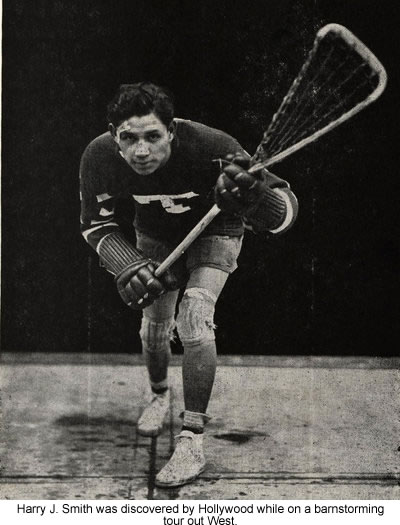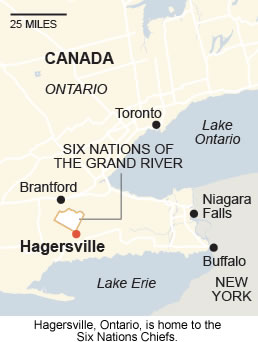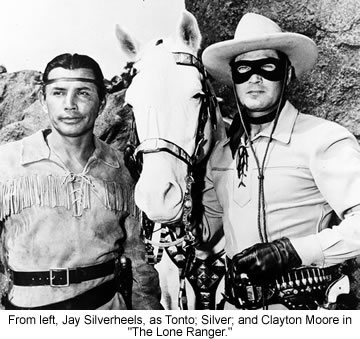 |
Canku Ota
|
 |
|
(Many Paths)
|
||
|
An Online Newsletter
Celebrating Native America
|
||
|
September 2013 - Volume
11 Number 9
|
||
|
|
||
|
A Sidekick's Little-Known
Leading Role in Lacrosse
|
||
|
by Jeff Z. Klein - New
York Times
|
||
|
That man was Harry J. Smith, but many years later, he became known to the world as Jay Silverheels, the actor who played Tonto in the "The Lone Ranger," a television series that ran from 1949 to 1957. This summer, there is renewed interest in Silverheels, after Johnny Depp's portrayal of Tonto in the big-budget film "Lone Ranger." How Smith, a lacrosse star of the Six Nations of the Grand River, became Silverheels, an actor who despised his own portrayal of an Indian, is a story that spans a continent and an era. But few realize that what put him on the path to Hollywood was the invention of indoor lacrosse — box lacrosse, as it is called in Canada and western New York. "He would never have been discovered, never have become Tonto, if he hadn't been in L.A. to play box lacrosse," said the historian Larry Power, compiler of the Internet archive Bible of Lacrosse. Zig Misiak, a historian in Brantford, Ontario, and the author of the recent self-published biography "Tonto: The Man in Front of the Mask," said: "Lacrosse is central to native culture — it's called the Creator's game. Historically, only males played the game, but now everyone at Six Nations plays it." Smith was born in 1912 at Six Nations, an area along the Grand River near Brantford that in 1794 was granted by King George III to members of the Iroquois Confederacy who remained loyal to the crown during the American Revolution. He was one of 11 children of A. G. E. Smith, a decorated officer in the Canadian forces during World War I. The concept took off, and within a couple of years, arenas, municipal auditoriums and armories across Ontario and New York State were hosting the "fastest game on two feet." Smith and his colorfully nicknamed brothers and cousins, including Russell (Beef), Sid (Porky) and George (Chubby), starred on teams in Toronto; Buffalo; Rochester; Atlantic City; and Akron, N.Y. "Once more, the Indians used their netted paddles as tomahawks to scalp the New York Giants, 16 to 10," one newspaper account read. Box lacrosse was a rough game, and Smith later remembered his fear. "I was so scared, I was weak," he told The Brantford Expositor in 1957. "I'd walk out on the floor shaking, thinking, I can't do it, I can't, I can't. Then the whistle would blow, and I'd play in a fury. Happened every time." By this time, Smith had adopted the nickname Silverheels for a brief middleweight boxing career — he reached an Eastern Golden Gloves title bout at Madison Square Garden — and for lacrosse. "One time, the boys won new white lacrosse shoes for playing good," another Six Nations lacrosse star, Ross Powless, recalled in 1989. "And Harry ran so fast in them new white shoes, all you could see was flashes of white at his heels. I guess they couldn't very well call him Whiteheels, him being Mohawk and all, so they called him Silverheels." In 1937, Harry and the rest of the Smith boys formed the core of a touring team that barnstormed the West. In Los Angeles, the comedian Joe E. Brown saw Harry play, encouraged him to try acting and got him a stunt role in a Basil Rathbone film, "Make a Wish." Smith, now Silverheels, put lacrosse aside and slowly built his Hollywood career. He appeared in 85 films, usually portraying an American Indian at a time when it was rare for an Indian actor to do so. Powless remembered the reaction at home when Silverheels played a Comanche or an Apache. "I used to get a kick out of Harry speaking Mohawk, especially when it didn't go with the story line," he said. "Us Mohawk would be sitting in the Brantford movie house laughing, and all the other people would be wondering what was so funny." Silverheels played Tonto with a dignity rarely accorded Indians on the screen, but he found the role demeaning and often expressed his frustration. "He's stupid," Silverheels said of the character during a trip home to Six Nations in 1957. "The Lone Ranger treats him like some kind of servant, and this seems to suit Tonto fine." In the 1960s, Silverheels helped start a workshop to support the work of Indian actors. He died in 1980 at 67. Today, Silverheels's lacrosse exploits are scarcely known in Los Angeles. His 92-year-old widow, Mary, and his son Jay, 52, said last month that he rarely spoke about the game. But back at Six Nations, where lacrosse remains very much a part of the culture, his exploits are not forgotten. "My uncle was an amazing lacrosse player," said his nephew Steve Smith, 64, who lives at Six Nations. His own nephew, Sid Smith, will play for the Chiefs when they travel to British Columbia this week for the Mann Cup finals, the Canadian championship, against the Victoria Shamrocks. "There are a lot of good players from here, and they come from families and generations of lacrosse players," Steve Smith said. "And Tonto, my uncle, was one of the best. |
|
|
||
|
|
||
| Canku Ota is a free Newsletter celebrating Native America, its traditions and accomplishments . We do not provide subscriber or visitor names to anyone. Some articles presented in Canku Ota may contain copyright material. We have received appropriate permissions for republishing any articles. Material appearing here is distributed without profit or monetary gain to those who have expressed an interest. This is in accordance with Title 17 U.S.C. Section 107. | ||
|
Canku Ota is a copyright ©
2000 - 2013 of Vicki Williams Barry and Paul Barry.
|
||
 |
 |
|
|
The "Canku
Ota - A Newsletter Celebrating Native America" web site and
its design is the
|
||
|
Copyright ©
1999 - 2013 of Paul C. Barry.
|
||
|
All Rights Reserved.
|
||
 At
Iroquois Lacrosse Arena in Hagersville, Ontario, the home
of the Six Nations Chiefs, box lacrosse champions of eastern Canada,
a photograph from 1931 hangs on the wall. Gazing ahead resolutely
and gripping a lacrosse stick is a handsome dark-haired Mohawk man
with a bandage over his right brow.
At
Iroquois Lacrosse Arena in Hagersville, Ontario, the home
of the Six Nations Chiefs, box lacrosse champions of eastern Canada,
a photograph from 1931 hangs on the wall. Gazing ahead resolutely
and gripping a lacrosse stick is a handsome dark-haired Mohawk man
with a bandage over his right brow.  Playing
on the fields at Six Nations, Harry Smith excelled at lacrosse at
a time when the game was undergoing a profound change. In 1931,
the owners of the N.H.L.'s Montreal and Toronto franchises needed
to fill summertime dates at their buildings. Their solution: shrink
traditional lacrosse to 7 men a side from 12 and move it indoors
to the Forum and to Maple Leaf Gardens. Professional box lacrosse
was born, with Smith a player on the Toronto Tecumsehs.
Playing
on the fields at Six Nations, Harry Smith excelled at lacrosse at
a time when the game was undergoing a profound change. In 1931,
the owners of the N.H.L.'s Montreal and Toronto franchises needed
to fill summertime dates at their buildings. Their solution: shrink
traditional lacrosse to 7 men a side from 12 and move it indoors
to the Forum and to Maple Leaf Gardens. Professional box lacrosse
was born, with Smith a player on the Toronto Tecumsehs.  Impressed
by his performance in the 1948 Humphrey Bogart film "Key Largo,"
the producers of the television adaptation of the "Lone Ranger"
radio series invited Silverheels to audition for the part of Tonto.
He beat out 35 other actors.
Impressed
by his performance in the 1948 Humphrey Bogart film "Key Largo,"
the producers of the television adaptation of the "Lone Ranger"
radio series invited Silverheels to audition for the part of Tonto.
He beat out 35 other actors.